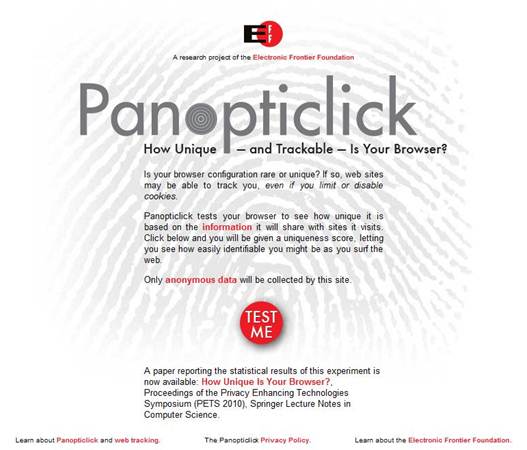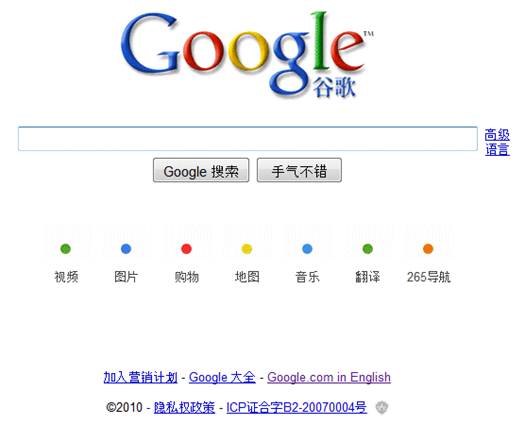The law
It response to the ever-increasing issues
surrounding privacy, EU Law has put in place the e-Privacy Directive. This
states that no user should be tracked without their consent. You may have
noticed the pop-up boxes that now appear at the top of websites announcing that
they use cookies; they will either require you to click to accept this or, in
some cases, state that by continuing to use the site you are giving your
consent.
The short explanations very rarely mention
anything about third-party cookies, and often appear only the first time you
visit the site. If you fail to spot the notifications or think you’ll have a
look when you have more time on your hands, you will continue to be tracked as
before.

Panopticlick
allows visitors to its site to establish whether their PC is trackable
To learn how the site uses cookies, you
normally have to click the privacy polices link highlighted in the message.
Sometimes you can select which cookies using your web browser’s private or
‘Incognito’ mode, which stop sites from adding permanent cookies or tracking
your web history.
Another sensible move is to visit the
security settings in your browser of choice and look for the ‘Do Not Track’ or
‘Do not allow third-party cookies’ option. Plug-ins such as Ghostery are
available for most browsers and offer an enhanced level of security, while
Internet Explorer users can use ‘Tracking Protection Lists’ to prevent know
offending sites to place cookies on their machine.
Sadly, even these settings can be overcome
by something called device fingerprinting. Your system is made up of lots of
small details such as the browser type, operating system, plug-ins, and even
system fonts that can be scanned and interrogated to reveal an individual digital
fingerprint that identifies your machine on the web.
The Electronic Frontier Foundation
(eff.org) is a digital rights group that campaigns against invasions of civil
liberties. To illustrate the effectiveness of device fingerprinting, it set up
the Panopticlick website. Here, users are able to measure how easily
identifiable their system are.
We tested our road-worn laptop and were
slightly unnerved to discover that, out of the 2,287,979 users that had scanned
their machines on the site, ours was unique and therefore trackable.
Some would agree that the ability for
companies to track our interests is a fair price to pay for the free services
we receive. After all, websites are only offering opportunities for advertisers
to pitch their products to us. Television, radio and cinema all do the same
thing, and use demographic profiling to promote certain products at calculated
times hence all the beer and crisp commercials during football coverage.
No-one forces us to use networks, and there
are alternatives to all Google’s online offerings. But it is such a bad thing
that we are being watched what have you got to hide? Well, that all depends on
who is doing the watching, and why.
The spying game
Currently negotiating its way through
parliament is the government’s Communications Data Bill, or the ‘Snooping
Bill’, as opponents prefer have termed it. This radical restructuring of
British law would force ISPs to retain communications data for all email, web
browsing and even mobile phone use in the UK.
The authorities would then be able to
access the information in a limited capacity at any time, or in its entirely
when granted a warrant. The government is also claiming that it will be able to
decode SSL encryption as part of the process..
For a nation that’s already heralded as the
most surveillance heavy country in the world, this might seem to many a step
too far. What some privacy campaigners see as the real problem, though, isn’t
necessarily the government prying into our digital lives (although that’s
obviously a concern that they are highly), but rather the fact so much
information about us will be collected and stored, with potentially dangerous
consequences.
Most of us would agree that although we
might not always like how our elected officials behave, we still have a
reasonably accountable government. We could also agree that while companies
such as Facebook and Google make money from us in a less-than-transparent
manner, they too are not out to harm us. But the fact that all are intent on
assembling hugely detailed data sets poses a problem if that information is
ever used by organisations that are not so benign.
In January 2010 Google announced that it
had been the victim of a sophisticated cyberattack originating in China. The
hackers had gone after the email addresses of human rights activists,
journalists, and some senior US officials. Wikileaks then released leaked cable
communications that suggested a senior member of the Chinese Politburo had been
involved in the attacks. Some reports suggested that the motivates behind the
attack were to identify and locate political dissidents who were speaking out
against the government’s human rights records.

In
January 2010 Google announced that it had been the victim of a sophisticated
cyberattack originating in China
The following year saw the rise of the
‘Hacktivist’. Modern day protestors against abuses of civil liberties or
digital freedom.
Among the high profile victims of groups
such as Anonymous and LulzSec and Sony, the US Bureau of Justice, our own Ministry
of Justice, the Home Office, several Chinese government sites and even the
Vatican... twice. In fact, Verizon released figures reporting that more than
100 million users’ data had been compromised by the Hacktivist groups in the
past year.
Although the motivation behind the
Hacktivists efforts are generally for the greater good, the ease with which
they seem to be able to either bring down or infiltrate supposedly secure sites
should bring into question the wisdom of having so much personal information
stored in one location, undoubtedly attacked to the internet.